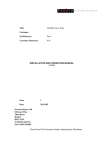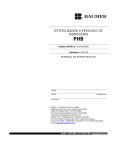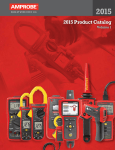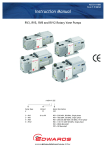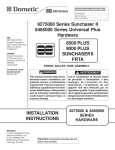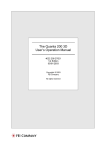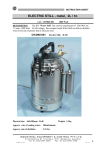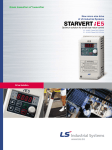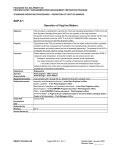Download Oil Degassing Rig manual (pdf 398KB)
Transcript
UK MANUFACTURERS OF THE LYOSCIENCE (LS) RANGE OF FREEZE DRYERS & BESPOKE HIGH VACUUM SYSTEMS | VACUUM PUMPS - SPARES - SERVICE Mobile Oil Degassing Rig INSTALLATION AND OPERATION MANUAL Please Read This Document before Operating the Machinery MechaTech Systems Ltd, Unit 9, Brunel Way, Thornbury Industrial Estate, Thornbury, Bristol. BS35 3UR Tel: + 44 (0) 1454 414723 | Email: [email protected] | www.mechatechsystems.co.uk Registered in England and Wales No.6469333 | VAT Reg no: 928 7530 93 © MechaTech Systems 2013 All rights reserved CONTENTS 1. DOCUMENTATION RECORDS 4 2. INTRODUCTION 5 2.1 Purpose 5 2.2 General safety 5 2.3 Unpack and inspect 5 2.4 Installation and Commission 2.4.1 Lifting and Handling Instructions 2.4.2 Initial setup 2.4.3 Electrical requirements 2.4.4 Mechanical requirements 2.4.5 Additional Documents to be supplied 3. OVERVIEW 3.1 4. 5. 6 6 6 7 7 7 8 General Description 8 OPERATION 9 4.1 Filling the reservoir 9 4.2 Filling component 10 4.3 Setting the temperature set point 10 4.4 Reset filter replacement indicator 11 4.5 Reset over temperature trip 11 4.6 Shut Down 11 4.7 Oil filter change 11 MAINTENANCE 12 Planned Maintenance 5.1.1 Daily Maintenance 5.1.2 6 monthly maintenance 5.1.3 Preventative Maintenance 5.1.4 Calibration 12 12 12 12 13 5.2 Recommended Spares 5.2.1 General 5.2.2 Albany Rotary Gear Pump / WEG electric motor 5.2.3 Edwards RV5 vacuum pump 5.2.4 Manufacturers literature 13 13 14 14 14 Contents Issue: 1 Page 2 of 16 6. TECHNICAL SPECIFICATIONS 15 7. ENVIRONMENT SPECIFICATIONS 16 Contents Issue: 1 Page 3 of 16 1. DOCUMENTATION RECORDS Issue Documentation Update Details Date Approval 1a Project version 1a developed and issued for internal review 22/06/11 JH 1 First formal issue to customer. 22/06/11 JH Section 1 Issue: 1 Page 4 of 16 2. INTRODUCTION 2.1 Purpose This manual provides installation and operation instructions for the Oil Degassing Rig. This manual and all accompanying documentation must be read before operating the vacuum system. Important safety information is highlighted as WARNING and CAUTION instructions; you must obey these instructions. The use of WARNINGS and CAUTIONS are defined below. 2.2 General safety instruction WARNING: Warnings are given where failure to observe the could result in injury or death to persons. CAUTION: Cautions are given where failure to observe the instruction could damage to the equipment, associated equipment or process. Refer to the accompanying manufacturers’ instruction manuals for the technical data on individual components. 2.3 Unpack and inspect Remove all packing material. CAUTION: Remove all packing material before operating system. If the equipment is damaged notify your supplier and the carrier in writing within three days. Section 2 Issue: 1 Page 5 of 16 2.4 Installation and Commission 2.4.1 Lifting and Handling Instructions Casters (9) are fitted allowing the unit to be pushed to location. 2.4.2 Initial setup I. Locate the Oil Degassing Rig in the required position, ensuring that the floor is adequate to support the equipment and that due consideration is given to: a) Air flow for ventilation b) Adequate space for maintenance. II. Once in final position the Vacuum Degassing Rig can be connected to the power supply. CAUTION: Exhaust gases must be ducted away from the surrounding atmosphere and suitably disposed. CAUTION: Do not obstruct any vacuum pump exhaust port (refer to manufacturer’s manual before operation). Section 2 Issue: 1 Page 6 of 16 2.4.3 Electrical requirements The unit is factory configured for 230volts (13 amps), single phase supply. Check that your voltage supply is compatible. If you operate the unit on the wrong voltage, you will damage it. CAUTION: Voltage 230Vac Frequency 50/60Hz Loading/power consumption 3 KW Earthing Class 1 (supply earth required) Fusing 13A Ensure that all framework panels are refitted before connecting to any services. Refer to Electrical Circuit Diagrams ref 8666 for supply connection details. WARNING: Failure to refit all panels prior to connecting to mains power may result in injury or death to the operator. 2.4.4 Mechanical requirements Pump Exhaust – NW25 flange Tool evac/reservoir fill –8mm push fit Fast reservoir fill (top of reservoir) – 12mm push fit 2.4.5 Additional Documents to be supplied Electrical Circuit Diagrams ref 8666 P&ID ref 10129 Declaration of Conformity ref 3IW082 Albany rotary Gear Pump maintenance instructions WATLOW Temperature controller EZ-Zone PM Express user’s manual ref 0600-0065-0000 Rev D WATLOW Temperature limit series L users manual Edwards Active Gauge Controller ref D395-90-000 Issue E Active Pirani Gauge D026-01-880 Issue B Please read these manuals before putting the unit into operation Section 2 Issue: 1 Page 7 of 16 3. OVERVIEW 3.1 General Description The Oil Degassing Unit is for the purpose of degassing/filtering [insert media]. The system consists of a mobile trolley mounted glass oil reservoir with aluminium base and top plates, fluid and vacuum pumps and a control panel with vacuum, fluid and temperature instrumentation. During the degassing cycle, the fluid pump continually circulates oil through an in-line filter, heater block and spreader plate, back into the reservoir. During this cycle the chamber is evacuated using the onboard vacuum pump. Temperature and pressure are monitored via gauges mounted on the control panel. During the Tool fill cycle, the operator evacuates the Tool. Then he diverts the flow of oil to fill the Tool. Oil returning from the Tool is passed back into the reservoir. An Indicator on the control panel, when illuminated, warns the operator of the need to replace the filter. Section 3 Issue: 1 Page 8 of 16 4. OPERATION WARNING: The glass chamber surface temperature can reach greater than 70 oC. Do not touch without wearing appropriate PPE WARNING: It is recommended that protective gloves or suitable PPE should be worn when operating the Degassing Rig. 4.1 Filling the reservoir 1. Connect the unit to the mains supply and switch on the mains isolator, located below the control panel. 2. Ensure The ‘System Air Admit’ valve located on the top of the reservoir is closed. The ‘RST Bypass’ valve is in the ‘Bypass’ position. The ‘Oil Flow / Reservoir fill’ valve is closed. The ‘Fast Fill ‘valve is closed. (positioned on top of the chamber. Yellow handle. See section 4.2) The ‘Vacuum Isolation’ valve is open. (handle vertical) 3. Depress the ‘Vacuum pump’ push button switch on the control panel to start the vacuum pump (button will illuminate). 4. Monitor the vacuum level. Allow the rig to evacuate until the analogue gauge on the top of the unit reads ~ -30 inHG 5. Attach a 12.0mm dia nylon pipe to the ‘fast fill ‘valve. Immerse the other end of the pipe into the container of oil to be transferred. 6. Open the ‘Vacuum Spoil’ valve located immediately above the ‘System Air Admit’ valve . This will maintain a pressure of approx 55- 65 mb during filling to control excessive foaming of the degassing oil. 7. Depress the ‘Circulation pump’ push button switch on the control panel to start the oil circulation pump. (Push button will illuminate). Section 4 to 5 Issue: 1 Page 9 of 16 8. Select the ‘Heater’ with its rotary switch on the control panel to initiate the heating of the oil . Note. The heaters will not turn on ( Rotary switch illuminated) until the oil level rises to actuate /lift the lower float. If the blue ‘Reset’ push button also illuminates depress to extinguish. The temperature controller displays the set point temperature in green (lower display value) and the actual temperature in red (upper display value). 9. The annunciator will sound when the chamber is at approximately the 28.0l level to warn the operator. The mute push button will illuminate. To mute the alarm press the ‘Mute’ push button. The indicator will extinguish. 10. Close the ‘Fast fill ' valve and disconnect the flexible pipe from the push-in fitting. 11. Leave the ‘Vacuum Spoil’ valve open for a further 35 – 45 mins (experience and oil type will determine) allowing the oil to heat, circulate and degass without excessive foaming. 12. Close the ‘Vacuum Spoil’ valve and observe the oil level to ensure Foaming is not excessive or has stopped. 13. Continue to degass oil for required time or until required vacuum level has been achieved. NOTE: For the heater to work there are three conditions that must be met. 1. The circulation pump must be running. 2. The over temp device must be reset. 3. There must be sufficient oil in the reservoir (measured by the lower level switch). 4.2 Filling component 1. Using the two 8.0 Dia push-in fittings, connect the ‘Oil to RST’ and ‘Oil from RST’ to the appropriate points on the RST/Component. 2. To evacuate the RST/Component. Open the ‘Oil flow from RST’ valve. And evacuate until the desired vacuum level is reached. 3. To fill the RST/Component with oil. Move the ‘RST Bypass valve’ from ‘Bypass’ to ‘Fill’ When the RST/Component filling is complete. Close the ‘Oil flow from RST’ valve and Move the ‘RST Bypass valve’ back to ‘Bypass’. 4.3 Setting the temperature set point The control set point value is displayed in the lower display window while in the auto mode of operation. To unlock the controller press and hold both the Up-arrow and the Down-arrow keys until LOC is displayed, then select 1 with Down-arrow key. To change the set point, press either the Up-arrow/Down-arrow keys to increment or decrement the set point value. Any change will automatically be entered after three seconds. To again lock the controller, follow the unlock procedure above and select 4. Section 4 to 5 Issue: 1 Page 10 of 16 4.4 Reset filter replacement indicator To reset the ‘filter blocked’ indicator after the filter has been replaced, depress the button in the end of the electrical connection at bottom of filter housing. The red flag showing inside of the button will then disappear. The filter indicator on the front control panel should then extinguish. 4.5 Reset over temperature trip Press Overtemp reset illuminated indicator switch to reset output once temperature is back in safe region. o The factory set over temperature set point is 100 C. 4.6 Shut Down 1. 2. 3. 4. Deselect the ‘Heater’ with its rotary switch (light will extinguish). Press the ‘circulation pump’ stop push button (light will extinguish). Press the ‘Vacuum pump’ stop button (light will extinguish). Switch off the mains isolator. 4.7 Oil filter change WARNING: When the filter needs to be changed ensure that the oil in the system is at ambient temperature. WARNING: Ensure that the electrical supply is isolated. 1. The oil filter housing is mounted onto a sliding platform. When the filter is to be changed slacken the M8securing screw in the slide housing (beneath the trolley base) and pull out the filter on its sliding platform as far as it will go. 2. Close the ‘Reservoir ISO valve’ beneath the chamber base plate (yellow ‘T’ handle) . 4. Unscrew filter drain bolt (the left hand and smaller hexagon at the base of the filter assembly) and drain oil into a suitable container. To aid the draining of the filter housing unscrew the hexagon headed plug in the top of the filter cap 5. Unscrew the filter cap (this may be quite stiff) and withdraw filter element from the top of the filter housing. Do not attempt to unscrew the filter body . 6. Fit new filter element and replace cap 7. Refit the two hexagon plugs using new sealing washers and return the filter slide to its original position. 8. Re-tighten securing screw and open the ‘Reservoir ISO valve’ Section 4 to 5 Issue: 1 Page 11 of 16 5. MAINTENANCE WARNING: Ensure that the electrical supply is isolated before starting any maintenance work. Ensure all power is disconnected and the oil has cooled sufficiently. Operate the manual air admit valve located on the top of the reservoir. Planned Maintenance When performing the following operations, refer to the components own working instructions for details on how to carry out the specified items; all of the necessary working instructions are supplied with this manual. 5.1.1 Daily Maintenance Inspect inner and outer glass surfaces for scratches or other surface damage Inspect / check the Albany pump for normal operation as follows: 1. Noise 2. Vibration 3. Bearing temperature 4. Product leaks 5. Seals for leakage Check oil level in vacuum pump 5.1.2 6 monthly maintenance RV5 full service Albany pump inspections as follows: 1. Check all pump bolting and connections are tight and free from corrosion 2. Check lubrication schedule 3. Check alignment 4. Check all ancillary equipment is in working order Calibrate gauges 5.1.3 Preventative Maintenance Albany pump lubricated bearings should be charged at 2000 hours and re-packed with new grease every 4000 hours Section 4 to 5 Issue: 1 Page 12 of 16 5.1.4 Calibration It is recommended that all vacuum gauging and sensors fitted to this unit be returned to MTS (or a relevant competent body) for service and calibration at least every 12 months. The time interval between services must to be reviewed by the customer during the units operating life. 5.2 Recommended Spares 5.2.1 General Table 1: Recommended Spare Parts List Description Part No Filter element. 12 micron Chamber seals (x2) Mist filter element Ultragrade 19 oil UE219AS08Z TR300 A22304198 H11025013 Gear Pump AP4 RV relief valve 240V 1ph 0.37KW 50Hz 5/8” Diameter x 6” long 240V-500W 39” Teflon leads and seal D02601000 Albany pump Cartridge heater. Gauge head Manufacturer PAL QVF Process Systems Ltd Edwards Vacuum Edwards High Vacuum Albany Pumps Watlow Edwards Vacuum Spares and service: All spare parts and servicing requirements are available from MechaTech Systems Ltd MechaTech Systems Ltd Unit 9 Brunel Way Thornbury Bristol BS35 3UR +44 (0)1454 414723 [email protected] www.mechatechsystems.co.uk Section 4 to 5 Issue: 1 Page 13 of 16 5.2.2 Albany Rotary Gear Pump / WEG electric motor For the Rotary gear pump and motor refer to the individual manufacturer’s literature for spares. 5.2.3 Edwards RV5 vacuum pump For the vacuum pump refer to the individual manufacturer’s literature for spares. 5.2.4 Manufacturers literature Manufacturer’s literatures for all major components have been included. Section 4 to 5 Issue: 1 Page 14 of 16 6. TECHNICAL SPECIFICATIONS Table 2: Technical Specifications FUNCTION Edwards Vacuum Pump Albany Circulation Pump Electrical Dimensions (w x h x l) Dimensions (h x dia) Weight (Empty) Noise Section 6 MODEL Overall PERFORMANCE Refer to manufacturers manual Refer to manufacturers manual 230V, 50Hz, 1 ph,3 KW 600 x 1750 x 1020 mm Chamber(internal) Overall Overall 706 x 300 mm 180 Kg < 80 dB RV5 AP4 RV Issue: 1 Page 15 of 16 7. ENVIRONMENT SPECIFICATIONS Temperature Operation 12 to + 40°C Temperature Storage -30 to +70°C Humidity Operation 50 to 90% RH (non-condensing) Humidity Storage 5 to 95% RH (non-condensing) Protection IP22 (Electrical control panel) Section 7 Issue: 1 Page 16 of 16
















